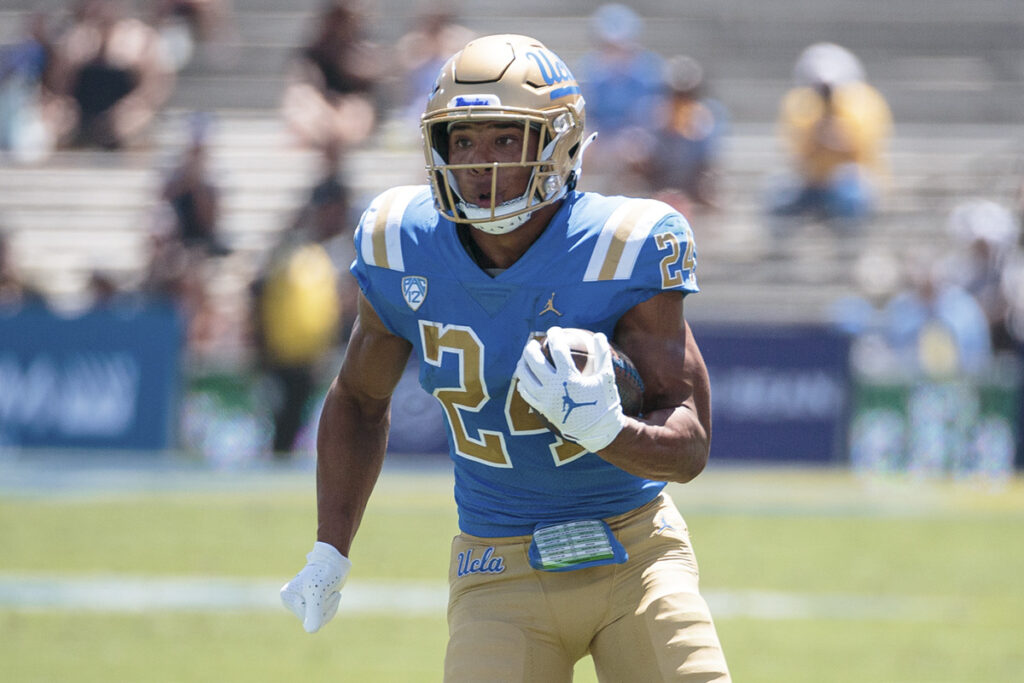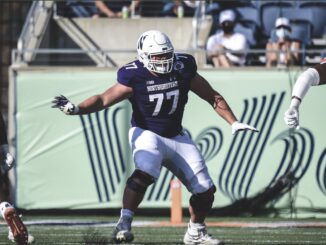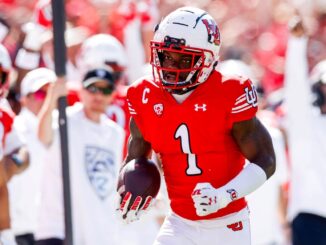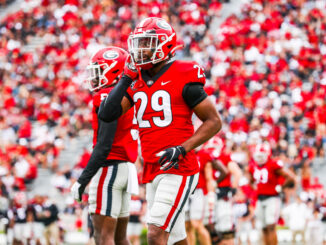This 2023 running back class appears to be one for the ages. It is headed by a truly elite talent at the top, but the list of players with potential to be significant contributors in the NFL extends well into day three. Here are my top ten running backs in the 2023 NFL Draft.
You can also download our free 2023 NFL Draft Guide, with over 130 in-depth prospect profiles!
1. Bijan Robinson, Texas (5-11, 215, Junior)

Pros: Robinson offers some of the best contact balance we have seen in a running back prospect in recent years. He forced 104 missed tackles in 2022 alone, which is the most in a single season since charting began in 2014. He possesses NFL-ready size, which he pairs with legitimate short area quickness and nifty footwork. Robinson ticks the box when it comes to vision and he runs with good patience. He is an effective third down back too, with good hands and reliability in pass protection.
Cons: There really aren’t many holes to Robinson’s game. One potential concern is ball security. He had a few issues with this in college, logging six fumbles in three seasons with the Longhorns. His long speed is also solid, but certainly not elite and can limit his ability to consistently break away from quicker defenders in the open field.
Projection: 1st round
2. Kendre Miller, TCU (5-11, 215, Junior)

Pros: Miller possesses some of the best vision in this year’s class. He has an innate understanding of how to pace his runs and a great feel for cutback opportunities. He also displays a good combination of size and athleticism, with light feet that you rarely see in a back of his size. This resulted in an impressive 16.9% of his career carries going for 10+ yards. Miller looked solid in his limited opportunities as a pass catcher and at just 20 years old he is one of the youngest players in this year’s class.
Cons: Whilst Miller has the kind of size profile to translate to the NFL, he doesn’t run with the kind of power that you might expect. He struggles when asked to move the pile in short yardage situations and is far more reliant on making defenders miss than he is breaking through tackles. Miller has also had only limited usage as a receiver with 29 career receptions. His technique in pass protection needs work too.
Projection: 2nd round
3. Zach Charbonnet, UCLA (6-0, 214, Senior)

Pros: Charbonnet offers the size and power that translates well to the NFL. He is a very tough runner, with impressive contact balance to weather arm tackles. His lower body strength is impressive and helps him to churn out tough yardage – it is a big reason he has 27 touchdowns over the last two seasons. Charbonnet has impressive burst for a bigger back too, with the fifth highest explosive run rate in the FBS last season. He also shown that he is comfortable as a pass catcher, with 60 receptions over the last two seasons.
Cons: Charbonnet is clearly more of a linear athlete than a shifty one and he doesn’t look nearly as good when asked to redirect or make a defender miss in the open field. There were also a number of occasions where he lacked the requisite decisiveness as a runner, particularly if the blocking in front of him wasn’t ideal. Whilst he did get good usage in the passing game, he isn’t an overly dynamic or varied route runner.
Projection: 2nd round
4. Jahmyr Gibbs, Alabama (5-9, 199, Junior)

Pros: Gibbs has outstanding short area quickness to navigate tight spaces. He pairs this with sub 4.4 speed that allows him to separate from defenders in the open field and take it to the house. Perhaps his best work comes in the passing game though. Gibbs is an incredibly dynamic pass catcher who is comfortable running a varied route tree and creating consistent separation. His hands are also exceptional, with just two drops on 105 career catchable targets.
Cons: The big worry with Gibbs is his size. At just 199 lbs he is built more like a wide receiver than a running back. There aren’t many NFL backs who can handle a heavy volume at that size and it might limit him to more of a rotational role at the next level. Unsurprisingly for a smaller back, Gibbs also struggles to break tackles and will routinely be taken down on first contact. He often gets overwhelmed in pass protection too.
Projection: 2nd round
5. Tank Bigsby, Auburn (6-0, 210, Junior)

Pros: Bigsby has three years of impressive production in the SEC, despite playing in a lacklustre Auburn offense. He displays impressive vision and decision making as a runner, routinely showing the ability to overcome poor blocking up front. He is a tough runner too, with good contact balance to create his own yardage. Despite his size, Bigsby is also very light and nimble on his feet, allowing him to navigate traffic and find the hole.
Cons: Whilst Bigsby has good short area quickness, his long speed isn’t ideal. He ran a 4.56 in the 40 yard dash and that shows on tape, with defenders being able to chase him down in the open field. As a pass catcher, he has decent experience but there are still some question marks. He isn’t much more than a checkdown option at this point and even then his hands were often spotty, dropping 11.6% of his career targets.
Projection: 2nd round
6. Tyjae Spears, Tulane (5-10, 201, rs-Junior)

Pros: Spears is an incredibly dynamic ball carrier. He showcases some of the best short area quickness and burst in this year’s class and is a twitched up and elusive runner. His ability to change direction on a dime is hugely impressive and allowed him to force over 100 missed tackles over the past two seasons. Spears also displays good vision and decision making as a runner, making him ideally suited for a zone-heavy offense.
Cons: At just 5’10” and 201 lbs, Spears is slightly built and looks more like a slot receiver than a running back. This results in some issues with his play strength, and despite his best efforts he clearly struggles to grind out hard yardage between the tackles when required. There will also be some very legitimate concerns surrounding his injury history, with Spears having already suffered two torn ACLs.
Projection: 3rd round
7. Roschon Johnson, Texas (6-0, 219, Senior)

Pros: Johnson has the size to handle a heavy workload at the NFL level. He pairs this with some impressive explosiveness, which allowed him to consistently create chunk plays during his time in college. Despite only switching to running back as a college freshman, he already possesses good vision and his contact balance is amongst the best in the class. Johnson is also an asset on third downs, with good hands and perhaps the best pass blocking ability in the class.
Cons: Johnson is a very explosive runner, but he does not look nearly as effective when asked to move laterally. His hips are a little stiff and he lacks the wiggle to make defenders miss in space. He is also high cut as a runner, leaving him susceptible to low shots from defender. Johnson’s long speed doesn’t match his short area quickness and he won’t win many foot races in the open field.
Projection: 3rd round
8. Eric Gray, Oklahoma (5-10, 207, Senior)

Pros: Gray is an incredibly smart runner who possesses exceptional vision and patience. His ability to quickly identify open space and navigate congested areas is amongst the very best in the class. He pairs this with the quick footwork to slalom through defenses and keep plays alive. Once he makes it to the open field, Gray is a smooth and slippery runner who forced 58 missed tackles on his 212 carries in 2022. His ability as a pass catcher is another big plus, with good hands and YAC ability.
Cons: Gray is on the smaller end of the scale when it comes to running backs. He lacks ideal play strength, which limits his ability to break through contact and churn out tough yardage between the tackles. This lack of strength also caused issues in pass protection where he was routinely overwhelmed by blitzers. Gray also falls short when it comes to his long speed, running a 4.62 at his pro day. He is one of the oldest running backs in the class too, turning 24 as a rookie.
Projection: 3rd round
9. Devon Achane (5-9, 188, Junior)

Pros: Achane is a legitimate track athlete playing running back. He was part of Texas A&M’s track and field team, running a 10.14 in the 100m – for context, that is faster than Tyreek Hill’s personal best. Achane pairs this with impressive change of direction quickness, showing the ability to navigate tight spaces and make defenders miss in space. He is an effective pass catcher who averaged 8.2 YAC per reception in his career, whilst also adding value as a kick returner on special teams.
Cons: The most obvious issue for Achane is his size. He is tiny by NFL standards and there aren’t many running backs receiving a high volume at his size at the next level. That size will also lead to some concerns about durability and versatility. Achane is far less effective as a between the tackles runner, averaging just 3.8 yards per attempt on such carries in 2022. He also struggled as a pass protector and will be a liability in that regard at the NFL level.
Projection: 3rd round
10. DeWayne McBride, UAB (5-10, 209, Junior)

Pros: Very few collegiate running backs can match McBride’s production, with him averaging 7.2 yards per attempt on his 484 career carries. He maintained this in spite of a heavy workload at UAB that saw him average 21.2 carries per game in 2022. McBride possesses some impressive power and he is able to consistently fight through contact in short yardage or goal line situations. He is also light on his feet, with the ability to make defenders miss in space, forcing at least 70 missed tackles in each of the last two seasons.
Cons: There are two main issues when it comes to McBride’s weaknesses. The first of these is ball security. He has logged nine fumbles over the past two years, which is the most in college football during that period. The other worry will be his complete lack of usage as a receiver, with just five catches to his name in three seasons. There are also some question marks surrounding the level of competition he faced at UAB. McBride only had two games against Power Five schools in which he averaged 3.8 yards per carry.
Projection: 4th round


